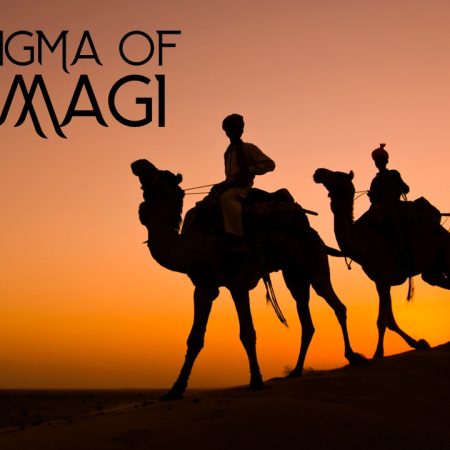
It has become almost ‘the norm’ to suggest that the visit of the Magi to Bethlehem occurred some two years after the birth of Christ and, in support of this thesis, the following points are made:
i. Herod’s edict to kill “all the male children… who were two years old or under” (Matthew 2:16)
However, this need not necessarily mean that, by his calculations and those of the Magi, the Christ had been born up to two years previously. After all, Herod was a man who killed without compunction, and the idea of a wide-ranging massacre would hardly have troubled him. This is a man who, in order to secure his position, had already had 45 members of a rival group put to death, not to mention three of his own sons, his own wife falsely accused and executed and her brother and grandmother killed.
His bloodlust is further heightened when the geographic scope of the massacre is noted – all infant boys, not just in Bethlehem but “in all that region” which included Ramah (Matthew 2:18), a town some ten miles away from Bethlehem.
Incidentally, without for a moment belittling the savage slaughter that Herod wreaked, we are not talking about the deaths of hundreds, or even thousands, of infants. Given the estimated population of that region at the time, numerous experts have calculated that the number of boys of that age would have probably been between 20 and 30
ii. A difference in the language used by Matthew and Luke
It is often pointed out that Matthew refers to Christ as pais or paidon (2:8, 9, 11, 13, 14, 16, 20, 21) while Luke uses the term brephos (2:12).
However, while it is true that brephos usually means infant, it is sometimes used of a young child (Luke 18:15-17; 2 Timothy 3:15). Similarly, pais/paidon is used of infants on several occasions (Luke 1:59, 66, 76; 2:17, 27; John 16:21; Hebrews 11:23). The words are clearly used interchangeably and so a conclusive argument cannot be made here for a distinction between the records of Matthew and Luke.
iii. The location of the family
It is true that while Luke records that Jesus was placed in a manger, “because there was no place for them in the inn” (2:7), Matthew says that the magi visited the child and his parents in “the house” (2:11). Kenneth Bailey, in his excellent book, Jesus Through Middle Eastern Eyes, has persuasively argued that our view of these terms is coloured by our western cultural understanding, and that Jesus was born “in a manger that was either built into the floor or made of wood and moved into the family living space” of a private home, because the guest room, which we have traditionally interpreted as ‘inn’, was already occupied by other guests. See my post on this subject. This understanding of the family’s circumstances removes any perceived conflict between the various accounts.
For me, most significant in all of this, is the statement in Luke 2:39 – “...when they had performed everything according to the Law of the Lord, they returned into Galilee, to their own town of Nazareth.” This comes immediately after Luke’s account of Mary and Joseph completing the required purification ceremony in the Temple in Jerusalem, which would have been on the 40th day after the birth of their son (2:32-38).
Some commentators suggest that between 2:38 and 39 there is a period of up to two years, during which time the family lived in Bethlehem, Joseph might have got a job, the Magi visited, the family went to Egypt and then travelled to Nazareth. But on the premise that ‘if the plain sense makes sense, seek no other sense’, that would force an unnatural reading of 2:39. Besides that, they wouldn’t have stayed in Jerusalem any longer than was necessary because of the danger from Herod’s son, Archelaus, who was now Governor of Judea (Matthew 2:22), and it would have been unthinkable to head further south, back to Bethlehem.
One other factor that cannot be overlooked in all of this is the impossibility of Herod being unaware of the birth of Christ – as he clearly was when the Magi arrived – for anything up to two years after the event. Given that he was born just a few miles away in Bethlehem, and that Christ has been publicly acknowledged as the Messiah by Simeon and Anna in the Temple when he was just 40 days old, it is unthinkable that word would not have reached Herod within hours of the birth.
Therefore, the events of Luke 2:22-38 must have taken place after the flight to Egypt, which itself must have been relatively brief since within six weeks the family are in Jerusalem. That’s by no means impractical or impossible, since we are only talking of a distance of about 40-50 miles between Bethlehem and Egyptian territory, a travelling distance of just 2-3 days. At some point, and in accordance with the prescribed ritual, Christ was circumcised on the eighth day after his birth (Genesis 17:12). This was customarily done by the boy’s father (Genesis 17:23; 21:4), and at that time a name would be given (Luke 1:59; 2:21).
We also know, if my calculations are correct, that Herod died within a few weeks, not years, of Jesus birth, news that was communicated to Joseph by an angel when he was in Egypt (Matthew 2:19-20).
Someone might suggest that given that the Magi would have taken at least three months to travel from Persia to Jerusalem, there was no way they could have arrived within a few days of Christ’s birth. However, that is based on an assumption that the star first appeared at the time of Jesu’s birth. It is not impossible at all that the star appeared some weeks and even months previous to Jesus’ birth; timed perfectly to allow them to travel and visit the Saviour in Bethlehem before the family had to flee to Egypt.
At the end of the day, of course, we cannot be absolutely sure about the timing, but we do have to endeavour to map out a timetable that is compatible with Scripture and not with Christmas traditions.
